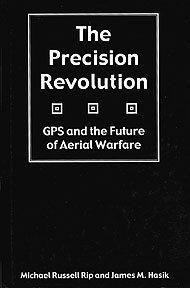 This information has been archived for reference or research purposes.
This information has been archived for reference or research purposes.
Archived Content
Information identified as archived on the Web is for reference, research or recordkeeping purposes. It has not been altered or updated after the date of archiving. Web pages that are archived on the Web are not subject to the Government of Canada Web Standards. As per the Communications Policy of the Government of Canada, you can request alternate formats on the "Contact Us" page.
Book Reviews
The Precision Revolution: GPS and the Future of Aerial Warfare
by Michael Russell Rip and James M. HasikAnnapolis: Naval Institute Press. 551 pages, $US48.95
Reviewed by Dr. Andrew Godefroy
For more information on accessing this file, please visit our help page.
 The
study of technological innovation in warfare has seldom received the
attention it deserves, but the ongoing debate amongst American scholars
over the transformation in the organization and capabilities of the
United States armed services has inspired a number of books focusing
on military technological subjects. Among these is a book by Michael
Russell Rip and James Hasik entitled The Precision Revolution:
GPS and the Future of Aerial Warfare, which offers an original
and perhaps unique assessment of the evolution of modern air warfare.
The
study of technological innovation in warfare has seldom received the
attention it deserves, but the ongoing debate amongst American scholars
over the transformation in the organization and capabilities of the
United States armed services has inspired a number of books focusing
on military technological subjects. Among these is a book by Michael
Russell Rip and James Hasik entitled The Precision Revolution:
GPS and the Future of Aerial Warfare, which offers an original
and perhaps unique assessment of the evolution of modern air warfare.
Placing the history of technology at the centre of the argument, rather than politics or strategy, offers a fresh insight into the ongoing American quest for accuracy that has fundamentally altered the way in which it projects air power around the globe. The Precision Revolution describes the advent of navigation-aided precision bombing during the Second World War and follows it through to the modern day. The authors devote several chapters to describing the efforts by both Britain and Germany to develop better technologies for strategic bombing targeting during the war, and then turn to the origins and evolution of space-based navigation that provide the cornerstone for today’s precision guided munitions. Individual chapters are also devoted to a variety of specific subjects – GPS weapons systems, GPS and electronic warfare, GPS jamming, and, most interestingly, the relationship between information, intelligence, and the limits of precision strike.
The theoretical and technical chapters (which are written in terms easily understood even by less-technically-oriented readers) are supported in turn with a number of case studies. In addition to sections dealing with cruise missile diplomacy and operations in the 1980s and 1990s, there are chapters devoted to precision strike in operations in Libya, the Persian Gulf, Bosnia, and Kosovo. The wealth of detail in these operational chapters provides fascinating reading, and should serve as a solid reference for any student of modern air power.
The timing of the book (published in 2002) allowed the authors to provide a postscript describing domestic attacks against the United States, including the 1994 attempt to crash a Cessna 150 into the White House and the tragic 2001 airliner attacks against the World Trade Center and the Pentagon. Though never wishing to provide plaudits for terrorist attacks, one cannot help but be morbidly impressed by the importance played by American GPS policy and technology in these events. Tracing decisions back to 1983 and the destruction of Korean Airlines Flight 007, Rip and Hasik illuminate decisions made to include GPS in commercial airliners and how that subsequently contributed to terrorists being able to strike at targets no larger than a block wide in 2001.
The book is well illustrated throughout, with photos, diagrams, and maps. The appendices provide further technical data on American GPS and Russian GLONASS satellite navigation systems, rounding out what is perhaps to date the seminal work on this subject. The authors are to be commended for their efforts.
![]()
Dr. Andrew Godefroy is an instructor and course developer at Royal Military College.






